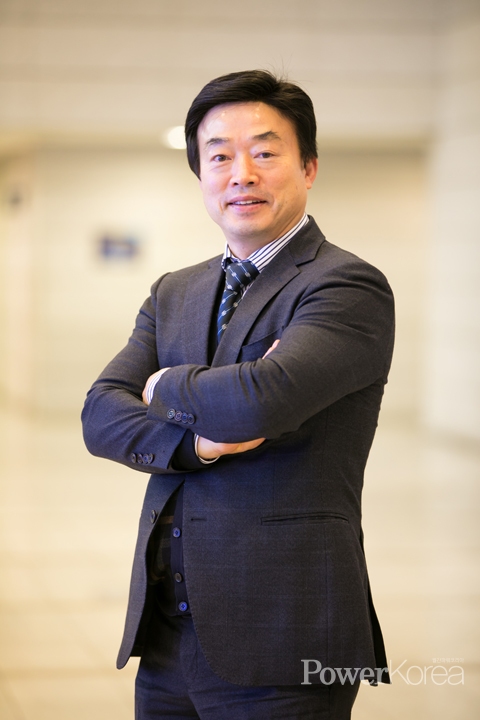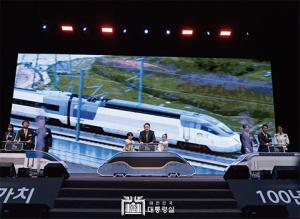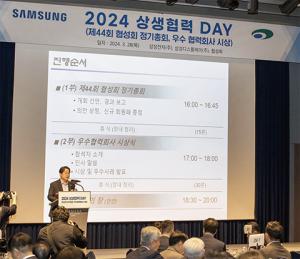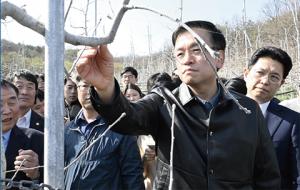 |
||
| ▲ 글로벌프로젝트관리연구소(주) 강신봉 대표이사(경영학박사) | ||
프로젝트(Project)는 회사, 조직 또는 단체가 유지되고 발전하기 위해 수행해야 하는 중요한 사업을 뜻한다. 기업은 프로젝트를 통해 새로운 제품이나 서비스를 개발하거나, 고객의 요청에 의한 프로젝트를 계약, 수행한다.제품개발․신사업개발을 비롯한 공장건설, 컴퓨터 도입, 시스템 개발, 플랜트 설계시공, 대형 공작기계의 수주 등은 물론 전사적(全社的)인 비용절감, 시장개발,판매 캠페인에 이르기까지 모두 프로젝트가 된다. 기업의 입장에서 이러한 태스크(task)가 점차 복잡 다변화되고 있는 상황으로 인해 산업계에서는 프로젝트 매니지먼트(Project Management, PM)의 중요성에 대한 인식이 커지고 있다. 월간파워코리아는 PM과 관련된 전문 교육을 통해 프로젝트 관리의 중요성을 널리 알리고 있는 글로벌프로젝트관리연구소(주) 강신봉 대표이사와 함께 PM 교육의 중요성에 대해 이야기를 나눠보았다.
강신봉 대표이사, 프로젝트관리의 대중화․전문화 위해 노력해
프로젝트 매니지먼트(PM)란 태스크의 명확화를 행한 후 프로젝트 계획을 작성, 이를 수행하면서 계획과 실적을 비교하고 계획으로의 피드백(환원조작)을 하면서 프로젝트의 완수를 확보하는 전체의 과정을 가리키는 말이다. 최근에는 정부 주도의 경제개발 프로젝트나 대규모의 건설․플랜트 산업, 조선․해양플랜트 등 다양한 분야에서 PM의 중요성이 대두되고 있다. PM의 대중화, 전문화를 위해 노력하고 있는 강신봉 대표이사는 30여 년간 현대엔지니어링, 현대건설, 포스코건설 등에서 근무하며 프로젝트관리, 품질관리, 공정관리, 리스크관리, 계약․클레임관리, 협상․갈등관리 VE(가치공학) 등 다양한 분야의 관리를 직접 담당한 바 있다.
당시는 국내 전반에 사업관리에 대한 매뉴얼이 부재한 상황이었다. 그는 재직 당시 해외사업 공사를 주로 진행하며 사업관리 분야에 대한 지식이 없어 많은 어려움을 겪었고, 그 때부터 관련 자격증을 취득하기 시작했다. 그는 미국 PMI(Project Management Institute)에서 발행하는 PMP(Project Management Professional) 자격과 영국에서 발행하는 PRINCE2(Project in Controlled Environment) 자격증을 취득하고 국내 최초의 PM대학원인 숭실대학교 국제통상대학원 국제프로젝트경영학과를 졸업, 관련 분야의 전문성을 인정받았다.
그는 "우리나라에서 가장 많은 인원이 종사하고 있는 분야가 건설 산업이다. 70년대부터 90년대까지는 개방적인 중동시장과 아시아의 빠른 경제성장으로 건설업이 붐을 일으킨 노동집약적 단순시공 위주의 시장이었다. 그러나 2000년대 들어 세계 경제 리스크가 증가하면서 현지 업체와 개도국 업체의 경쟁력이 지속 증대하고 사업 방향 역시 프로젝트 파이낸싱이나 투자개발사업 등으로 변화하면서 고도의 기술집약적인 사업으로 변화하게 되었다. 해외에서 건설 시장의 활로를 찾기 위해서는 선진 PM에 대한 습득이 가장 중요하다"라고 강조했다.
고려대학교․중앙대학교 등에서 PM전문교수로서 글로벌 PM 강의 진행
한국글로벌PM전문가포럼 회장 등 다방면에서 활동
강 대표이사는 "기계․전기․건축․토목 등 기술 분야에 대해서는 전국 대학교에 전문학과가 있고 전문자격증 제도도 존재한다. 반면 계약, 공정, 원가, 품질, 의사소통 관리 등의 프로젝트 관리 분야에 대해서는 전문학과도 거의 없고 자격증 제도도 없다. 현재 세계적인 산업의 추세를 볼 때 미래 산업으로서 각광받는 것은 기술 분야보다 관리 분야라고 할 수 있다. 선진국은 관리 기술을 보유하고 전문기술 분야는 갖춰진 시스템에 의해 일할 수 있도록 하도급만 주면 되는 시스템이기 때문이다. 눈에 보이는 일만 해서는 부가가치를 높일 수 없다"라고 강조했다.
이에 강 대표이사는 고려대학교 글로벌건설엔지니어링학과와 중앙대학교 건설대학원 겸임교수, (재)건설기술교육원, 해외건설협회 등에서 PM교수를 맡아 '글로벌 프로젝트 공정관리', '글로벌 프로젝트 리스크관리', '글로벌 프로젝트 품질관리', ‘프로젝트 협상 및 갈등관리’ 등 다양한 강의를 진행하고 있다. 그는 지난 2015년부터 글로벌프로젝트관리연구소(GPM Lab)를 설립하고 20여 명의 자문위원과 함께 프로젝트관리, 해외 사업관리, 계약 컨설팅, VE(Value Engineering, 가치공학) 컨설팅, 경영 컨설팅 등 다양한 PM 분야의 연구개발과 보급에 정진하고 있다. 특히 그는 (사)피엠전문가협회 부회장, (사)한국플랜트기술협회 부회장, 한국글로벌PM전문가포럼 회장, 2018 제5회 글로벌PM 국제컨퍼런스 조직위원장, 공학인재양성특별위원회 부위원장, (사)한국건설관리학회 이사로서 K-CMBOK 집필위원장 등으로 활발히 활동하며 국내외 산업현장․학교․공공기관을 대상으로 교육 및 컨설팅을 진행하고 있다.
청소년들 대상으로 한 '리틀PM' 커리큘럼 도입
"프로젝트 관리 문화의 중요성 널리 알릴 것"
또한 그는 PM 분야의 인재 육성을 위해 국내 최초로 유소년 및 청소년들을 대상으로 한 '리틀PM' 커리큘럼을 도입하기도 했다. 그는 "기존 PM 교육의 대상이 되는 것은 주로 대학원생 이상으로 회사를 다니고 있는 분들이 많았다. 그러나 나이가 들면 쉽게 변화하기 힘든 것이 사실이라, 어떻게 하면 PM 보급을 더 빨리 할 수 있을까를 고민하던 끝에 리틀PM을 보급하게 되었다"고 언급했다.
리틀PM은 초․중․고등학교, 대학생들이 글로벌 프로젝트 관리를 배우고 익히는 데 필요한 여러 가지 활동과 도구들을 통해 문제나 과제를 해결하기 위한 목표를 정하고, 관리 계획을 수립하여 프로젝트관리 활동을 효율적으로 수행하고, 개인 인생의 목표와 행복한 삶을 살아갈 수 있는 실제적인 방법을 배우고 경험하는 활동이다. 지난 2015년 포스코건설과 인천사회복지협의회가 리틀PM봉사단을 창설한 것을 시작으로 인천논현중학교 학생들을 대상으로 한 '꿈 지도 만들기 과정', '리틀PM전문가 과정' 등이 여러 차례 진행되어 호평을 얻었다. 또한 강 대표이사는 작년 12월부터 '리틀PM전문강사(LPMI) 육성과정'을 진행하여 현재까지 20여 명의 전문 강사가 배출되었고 올 4월에는 제3기 과정이 진행될 예정이라고 한다.
그는 "리틀PM뿐만이 아니라 청소년PM, 또 엄마/아빠PM, 시니어PM 등 다양한 과정을 통해 우리 인생의 모든 것이 프로젝트라는 것을 알리고 전문기술과 관리기술을 통해 삶의 보람을 주는 과정에 주력하고자 한다. 크게는 우리 산업 분야에서 글로벌 경쟁력을 확보하는 활동이기도 하면서, 동시에 유소년, 청소년기부터 글로벌 프로젝트 경쟁력을 확보하는 교육"이라며 "앞으로도 우리나라의 글로벌경쟁력 확보를 위해 PM의 발전에 주안을 두고 프로젝트 관리 문화의 중요성을 널리 알리고 PM대중화를 통한 선진 대한민국 건설의 초석을 다지기 위해 백방으로 노력할 것"이라는 포부를 밝혔다.
“Taking initiative in spreading the importance of project management”
Gang Shin-bong, Director of Global Project Management Lab (GPM Lab), Doctor of Business Administration
A project can be explained as a task for company or organization to develop products or programs, sign contracts, build factories and bring marketing strategies, etc. that are needed to maintain or develop the businesses. Project Management (PM), on the other hand, is to manage systematically the whole process of a project from layout and implementation to result and feedback. As ‘a task’ involves multiple bodies and complicated procedures nowadays, the effective use of PM is becoming more critical than ever. Gang Shin-bong, Director of Global Project Management Lab (GPM Lab) and Doctor of Business Administration, is a specialist in the field working for Hyundai E&C and POSCO E&C in the departments of project management, quality management, process management, risk management, contract and claim management, negotiation and conflict management and value engineering for the last 30 years. He obtained a PMP (Project Management Professional) certificate issued by PMI (Project Management Institute, US) and a PRINCE2 (Project in Controlled Environment) certificate issued in the UK. He also obtained a master’s degree in International Project Management at Soongsil University Graduate School of International Studies which is credited for being the Korea’s first graduate school of PM. “Engineering and construction is the industry that most Koreans are earning their living. Back then in the 70s to 90s, the industry was labor-intensive but the dawn of a new millennium required knowledge and skills in project finance and investment which are technology-intensive. Therefore, securing the advanced knowledge and skills of PM is a must if we are to secure the engineering and construction markets overseas as many developing countries are rapidly catching up in terms of competitiveness” explains Gang and adding “It is noteworthy that there is hardly ever a university department of PM (contract, process, unit price, quality and communication, etc.) in Korea not to mention the related certificates. I personally think that the future industry will require more of management field than technology field considering the current trend in the global industries. In other words, advanced countries with secured technologies ‘manage’ the projects which are then done by subcontractors. ‘Manage’ in this case is a high value added.” Recognizing his professionalism in the field and qualifications, a number of organizations are inviting Gang to give lectures and they are Korea University Department of Global Engineering and Chung-Ang University Graduate School of Engineering and Construction (as adjunct professor) and KICTE and the International Contractors Association of Korea (as PM professor giving lectures on ‘global project management’, ‘global project risk management’, ‘global project product management’ and ‘project negotiation and conflict management’). Gang established GPM Lab in 2015 and is providing services with his 20 advisory committee members for project management, overseas business, contract consulting, value engineering consulting and management consulting. Apart from the professor’s role, Gang currently is serving as Vice President of the Industry Council of Project Management, Vice President of the Korea Plant Technology Association, President of the Korea Global PM Forum, Chairman of the International Strategic PM Conference (5th, 2018), Vice Chairman of the Special Committee for Fostering Talented Engineers, a board member of the Korea Journal of Construction Engineering and Management and Chairman of K-CMBOK. It is noteworthy that he introduced ‘Little PM’, a PM curriculum designed for youth. Students from elementary to university level can use Little PM as an effective tool to improve their PM capability through various questions, tasks and activations. POSCO E&C and the Incheon Metropolitan City Association of Social Workers launched ‘Little PM Corps’ in 2015 to hold a number of PM courses and Gang also has fostered 20 Little PM instructors as of March 2018. Gang says “It is my goal to introduce PM programs not only for youth but also for mothers, fathers and seniors, all members of the society, so that they come to know the importance of PM since I think our lives are a series of projects in a way. I will keep doing my best to introduce effective PM programs and make contribution to raising Korea’s global competitiveness.”
Note: <Power Korea> “rewrites” the Korean article in English “concisely” for native English speakers and staff of foreign missions in Korea.
이승호 기자 tauton@naver.com







